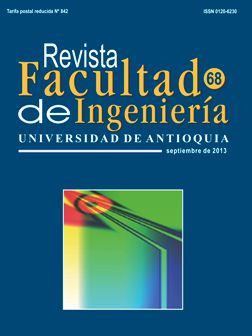Automated design of customized implants
DOI:
https://doi.org/10.17533/udea.redin.17164Keywords:
KBS, CAD, intelligent design, rapid prototyping, cranial implantsAbstract
This paper presents a model capable of design a customized cranial implant directly from a medical imaging process, whose output will be a file in a manufacture system recognizable format.The proposed system has been created by linking two computer prototypes developed during the present research and studying the inner and outer related technologies. The core of the model is the KBS (Knowledge Based System) technology, able to store and manage medical data, as well as designer knowledge, in order to use this information in the implant design process. The aim of this project is to obtain a tool to improve the design process, the biocompatibility with patient and reduce final costs, which can be operated without necessity of wide knowledge from the user.
Downloads
References
M. Cabrera, J. Burgelmen, M. Boden, O da Costa, C. Rodríguez. eHealth in 2010: Realising a Knowledge-based Approach to Healthcare in the EU. European Commission Directorate-General Joint Research Centre Technical Report EUR 21486. Seville, Spain. 2004.
P. D’Urso, W. Earwaker, T. Barker, M. Redmond, R. Thompson, D. Effeney, F. Tomlinson. “Custom cranioplasty using stereolithography and acrylic”. British Journal of Plastic Surgery. Vol. 53. 2000. pp. 200-204. DOI: https://doi.org/10.1054/bjps.1999.3268
H. Eufinger, C. Rasche, M. Wehmöller, K. Schmiederc, M. Scholzc, S. Weihed, P. Scherera. “CAD/CAM titanium implants for cranioplasty--an evaluation of success and quality of life of 169 consecutive implants with regard to size and location”. Computer Assisted Radiology and Surgery. Vol. 1281. 2005. pp. 827-31. DOI: https://doi.org/10.1016/j.ics.2005.03.074
R. Dooley, G. Heimke, A. Dingankar, E. Berg, E. Kimbrough. “Automated design and analysis system for design of custom orthopedic implants”. Proceedings of the first international conference on Industrial and engineering applications of artificial intelligence and expert systems. Vol. 1. 1988. pp. 405-12. DOI: https://doi.org/10.1145/51909.51955
D. Whittaker. “Custom-designed hip implants through knowledge-based engineering”. Materials & Design.Vol. 12. 1991. pp. 103-4. DOI: https://doi.org/10.1016/0261-3069(91)90114-J
O. Tziovaras. Customised implant design for the knee joint. X Congreso Internacional de Ingeniería de Proyectos. Valencia, España. 2006. pp. 630-635.
T. Wu, L. Fietena, M. Engelhardt. “Knowledge-based individual implant design based on reference models for craniofacial reconstruction”. International Journal of Computer Assisted Radiology and Surgery. Vol. 1. 2006. pp. 259-61.
A. Rose, M. Klein, T. Krueger. Individual bone implant modeling using planned resection lines for facial and cranial tumor resection. 4th European Conference of the International Federation for Medical and Biological Engineering. Ed. Springer Berlin – Heidelberg. Berlin, Germany. Vol. 22. 2009. pp. 944-947. DOI: https://doi.org/10.1007/978-3-540-89208-3_225
J. Gao, W. Xu, Z. Ding. “3D finite element mesh generation of complicated tooth model based on CT slices”. Computer Methods and Programs in Biomedicine. Vol. 82. 2006. pp. 97-105. DOI: https://doi.org/10.1016/j.cmpb.2006.02.008
M. Truscott, D. de Beer, G. Booysen, L. Barnard. Bone Development through CT/CAD/CAM/RP. 10èmes Assises Européennes de Prototypage Rapide. AFPR – Association Française de Prototypage Rapide. Paris, France. 2004. pp.107-114
S. Singare, L. Yaxiong, L. Dichen, L. Bingheng, H. Sanhu, L. Gang. “Fabrication of customised maxillo-facial prothesis using computer-aided design and rapid prototyping techniques”. Rapid Prototyping Journal.Vol.
2006. pp. 206-13.12. L. Hieu, N. Zlatov, J. Vander, E. Bohez, L. Khanh, P. Binh, P. Oris, Y. Toshev. “Medical rapid prototyping applications and methods”. Assembly Automation. Vol. 25. 2005. pp. 284-292. DOI: https://doi.org/10.1108/01445150510626415
J. Ho, S. Kleiven. “An automatic method to generate patient specific finite element head model”. Journal of Biomechanics. Vol. 39. 2006. pp. S428-S. DOI: https://doi.org/10.1016/S0021-9290(06)84743-3
B. Starly. Biomimetic design and fabrication of tissue engineered scaffolds using computer aided tissue engineering. PhD Thesis. Drexel University. Philadelphia, Pennsylvania, USA. 2006.
S. Lohfeld, V. Barron, P. McHugh. “Biomodels of bone: a review”. Annalsof Biomedical Engineering.Vol. 33. 2005. pp. 1295-1311. DOI: https://doi.org/10.1007/s10439-005-5873-x
I. Gibson, L. Cheung, S. Chow, W. Cheung, S. Beh, M. Savalani, S. Lee. “The use of rapid prototyping to assist medical applications”. Rapid Prototyping Journal. Vol. 12. 2006. pp. 53-58. DOI: https://doi.org/10.1108/13552540610637273
M. Naing, C. Chua, K. Leong, Y. Wang. “Fabrication of customised scaffolds using computer-aided design and rapid prototyping techniques”. Rapid Prototyping Journal. Vol. 249. 2005. pp. 259. DOI: https://doi.org/10.1108/13552540510612938
V. Chulvi, C. Muñoz. Prototipado rápido + PEEK = Andamios para huesos. XI Congreso Internacional de Ingeniería de Proyectos (AEIPRO). Lugo, España. 2007. pp. 602-612.
A. Lipowicz. “Advanced methods of hard tissue scaffold and implant fabrication”. Journal of Biomechanics. Vol. 39. 2006. pp. S216 DOI: https://doi.org/10.1016/S0021-9290(06)83794-2
G. Converse, W. Yue, R. Roeder. “Processing and tensile properties of hydroxyapatite-whisker-reinforced polyetheretherketone”. Biomaterials. Vol. 28. 2007. pp. 927-935. DOI: https://doi.org/10.1016/j.biomaterials.2006.10.031
Downloads
Published
How to Cite
Issue
Section
License
Copyright (c) 2018 Revista Facultad de Ingeniería

This work is licensed under a Creative Commons Attribution-NonCommercial-ShareAlike 4.0 International License.
Revista Facultad de Ingeniería, Universidad de Antioquia is licensed under the Creative Commons Attribution BY-NC-SA 4.0 license. https://creativecommons.org/licenses/by-nc-sa/4.0/deed.en
You are free to:
Share — copy and redistribute the material in any medium or format
Adapt — remix, transform, and build upon the material
Under the following terms:
Attribution — You must give appropriate credit, provide a link to the license, and indicate if changes were made. You may do so in any reasonable manner, but not in any way that suggests the licensor endorses you or your use.
NonCommercial — You may not use the material for commercial purposes.
ShareAlike — If you remix, transform, or build upon the material, you must distribute your contributions under the same license as the original.
The material published in the journal can be distributed, copied and exhibited by third parties if the respective credits are given to the journal. No commercial benefit can be obtained and derivative works must be under the same license terms as the original work.










 Twitter
Twitter